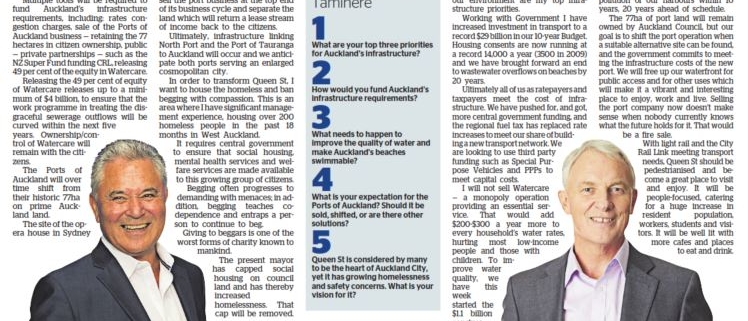Infrastructure: Mayoral motivations
Tim McCready put these questions to mayoral hopefuls Phil Goff and John Tamihere
- What are your top three priorities for Auckland’s infrastructure?
- How would you fund Auckland’s infrastructure requirements?
- What needs to happen to improve the quality of water and make Auckland’s beaches swimmable?
- What is your expectation for the Ports of Auckland? Should it be sold, shifted, or are there other solutions?
- Queen St is considered by many to be the heart of Auckland City, yet it has growing homelessness and safety concerns. What is your vision for it?
Phil Goff
Building a transport network to cater for population growth and ease congestion, infrastructure to allow home building to meet demand and cleaning up our environment are my top infrastructure priorities.
Working with Government I have increased investment in transport to a record $29 billion in our 10-year Budget. Housing consents are now running at a record 14,000 a year (3500 in 2009) and we have brought forward an end to wastewater overflows on beaches by 20 years.
Ultimately all of us as ratepayers and taxpayers meet the cost of infrastructure. We have pushed for, and got, more central government funding, and the regional fuel tax has replaced rate increases to meet our share of building a new transport network. We are looking to use third party funding such as Special Purpose Vehicles and PPPs to meet capital costs.
I will not sell Watercare — a monopoly operation providing an essential service. That would add $200-$300 a year more to every household’s water rates, hurting most low-income people and those with children. To improve water quality, we have this week started the $1.1 billion construction of a huge interceptor from Grey Lynn to Mangere and are separating stormwater from wastewater. Together those measures will substantially stop pollution of our harbours within 10 years, 20 years ahead of schedule.
The 77ha of port land will remain owned by Auckland Council, but our goal is to shift the port operation when a suitable alternative site can be found, and the government commits to meeting the infrastructure costs of the new port. We will free up our waterfront for public access and for other uses which will make it a vibrant and interesting place to enjoy, work and live. Selling the port company now doesn’t make sense when nobody currently knows what the future holds for it. That would be a fire sale.
With light rail and the City Rail Link meeting transport needs, Queen St should be pedestrianised and become a great place to visit and enjoy. It will be people-focused, catering for a huge increase in resident population, workers, students and visitors. It will be well lit with more cafes and places to eat and drink.
John Tamihere
My top three priorities for Auckland’s infrastructure are transport, housing, sanctity of water supply and disposal of waste water.
Multiple tools will be required to fund Auckland’s infrastructure requirements, including: rates congestion charges, sale of the Ports of Auckland business — retaining the 77 hectares in citizen ownership, public — private partnerships — such as the NZ Super Fund funding CRL, releasing 49 per cent of the equity in Watercare.
Releasing the 49 per cent of equity of Watercare releases up to a minimum of $4 billion, to ensure that the work programme in treating the disgraceful sewerage outflows will be curved within the next five years. Ownership/control of Watercare will remain with the citizens.
The Ports of Auckland will over time shift from their historic 77ha on prime Auckland land.
The site of the opera house in Sydney is a case in point, given that site was Sydney’s port.
Accordingly, as the port business winds down, it is imperative that we sell the port business at the top end of its business cycle and separate the land which will return a lease stream of income back to the citizens.
Ultimately, infrastructure linking North Port and the Port of Tauranga to Auckland will occur and we anticipate both ports serving an enlarged cosmopolitan city.
In order to transform Queen St, I want to house the homeless and ban begging with compassion. This is an area where I have significant management experience, housing over 200 homeless people in the past 18 months in West Auckland.
It requires central government to ensure that social housing, mental health services and welfare services are made available to this growing group of citizens. Begging often progresses to demanding with menaces; in addition, begging teaches co-dependence and entraps a person to continue to beg.
Giving to beggars is one of the worst forms of charity known to mankind.
The present mayor has capped social housing on council land and has thereby increased homelessness. That cap will be removed.




Leave a Reply
Want to join the discussion?Feel free to contribute!